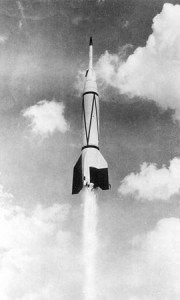“First” US Rocket to Reach Outer Space
 February 24, 1949
February 24, 1949
Considered the first US rocket to reach outer space by NASA, Bumper 5 is launched from the White Sands Proving Grounds in New Mexico. The rocket was a combination of a modified captured German V-2 ballistic missile with a US-designed WAC Corporal rocket. It reached a record altitude at the time of 244 miles. The later named and established Kármán line, which is 62.1 miles (100 kilometers) above the Earth’s sea level, is considered the upper limit of Earth’s atmosphere and the beginning of Outer Space.
Interestingly, according to information found online there were other previous captured V-2 test flights launched from White Sands that reached higher than 100 km prior to Bumper 5. Still, the significance of Bumper 5 was that it was the first successful two-stage rocket launch, which proved the feasibility of the basic design of staged rockets that made successful space flight a reality.
